The Thrill of Longboard Racing: A Deep Dive


Intro
Longboard racing represents more than just high speeds and adrenaline; it's a fusion of art and physics on wheels. This niche sport has captured a wide audience—from thrill-seekers to expert riders, showcasing what it truly means to master the longboard. The essence of racing is steeped in a unique culture that marries both individual pursuits and community spirit.
As we peel back the layers of this engaging sport, we'll explore various aspects: the techniques that form the backbone of successful racing, the essential gear that ensures safety and performance, and the stories that embody its cultural significance. Whether you're a novice aiming to ride with confidence or a seasoned racer seeking to refine your edge, this guide will illuminate what lies at the heart of longboard racing.
Intro to Longboard Racing
Longboard racing stands at the intersection of thrill, skill, and community. It's not just a pastime for those who enjoy speed on four wheels; it represents a culture that celebrates freedom and personal expression. For newcomers, understanding the dynamics of longboard racing can transform a basic hobby into a profound passion. Seasoned riders, on the other hand, often seek deeper insights into techniques, gear, and community engagement to elevate their experience.
The importance of grasping what longboard racing is all about cannot be overstated. First and foremost, it imparts a sense of belonging. When you join the ranks of longboarders, you're not just partaking in a sport; you're joining a vibrant community that shares a love for the excitement and challenges that come with racing downhill or mastering slalom courses.
Moreover, the diverse styles of racing cater to various preferences, whether someone is adrenaline-hungry or seeks a more laid-back, skill-oriented approach. This versatility is what hooks many into the sport.
Benefits and Considerations
Participating in longboard racing can bring several benefits:
- Physical Fitness: Racing demands a good level of physical activity where balance, coordination, and strength are developed. Continuous movement while racing can also improve cardiovascular health.
- Mental Focus: Navigating through winding paths requires acute awareness and strategic thinking, encouraging riders to stay sharp and alert.
- Social Connections: From local meet-ups to larger competitions, the opportunity to forge friendships and networks is substantial. The community prides itself on welcoming riders of all levels, so you're likely to find a group that resonates with you.
However, it’s wise to acknowledge certain considerations. Newcomers may face an intimidating learning curve. Some individuals might discover that specific skills take time to develop. It’s crucial to approach the sport with patience and perseverance. Choosing the right gear can also be overwhelming, since the variety available today is staggering.
Navigating Your Journey
As we delve deeper into this article, let’s take stock of the key aspects that encompass longboard racing:
- A historical overview that explains where it began and how it has evolved.
- An examination of various racing formats, from downhill to freeride events.
- A detailed discussion on essential gear that ensures both performance and safety.
- Techniques and strategies designed to help individuals navigate races more effectively.
- An exploration of community culture and future trends that will shape the sport.
Overall, by understanding the intricacies of longboard racing, readers will not only equip themselves with knowledge but also develop a sense of appreciation for this dynamic sport. One can think of it as peeling back the layers of an onion – the more you learn, the more you appreciate the flavors within.
Historical Context of Longboard Racing
Understanding the historical context of longboard racing opens a window into how this vibrant sport has transformed over the decades. Longboard racing has roots that trace back to the surfing culture of the 1950s, reflecting the pursuit of speed and style that surfers enjoyed on the waves. As enthusiasts began to see the potential of riding on wheels over pavement, longboarding evolved from a casual pastime into a recognized competitive sport, marking a significant shift in the skateboarding scene.
The importance of this history cannot be overstated. Knowing where the sport originated sheds light on its present dynamics and cultural significance. A deeper understanding allows racers and enthusiasts alike to appreciate the evolution of techniques, gear, and community values that have shaped longboarding into what it is today. Following these historical threads gives clarity on contemporary issues in racing, such as safety measures, equipment standards, and community engagement.
Origins of Longboarding
Longboarding has its origins deeply rooted in the early lugeing and sidewalk surfing, where surfers aimed to simulate the feeling of riding ocean waves. During the late 1940s and throughout the 1950s, skateboards began to proliferate as a means to surf on land. Early boards were often constructed from repurposed wooden crates or two-by-fours, showcasing creativity and resourcefulness.
The longboards of that era had a peculiar charm. Various designs emerged, emphasizing length and stability, characteristics that set them apart from traditional skateboards. Riders might have been seen gliding down the streets of California, merging their surfing skills with this new medium, finding joy in the act of riding itself.
As the sport captured the hearts of many, they soon began organizing races on the streets. These early competitions were often informal, driven by a shared passion rather than structured rules or regulations. This grassroots spirit is what allowed longboarding to flourish, gathering a community of riders bonded by their love for speed and adventure.
Evolution into a Competitive Sport
The shift from casual fun to formal competition happened as more riders started participating in events that showcased their skills in a racing format. By the 1970s and 1980s, longboard racing began to take form, with organized events and burgeoning enthusiasm leading to the establishment of groups and associations that focused on promoting the sport.
"What started as a few friends racing down the block has evolved into a thriving community that spans the globe," says longtime racer and organizer.
With this evolution came the need for improved safety measures and equipment. Riders started to develop specialized longboards tailored for different styles of racing, alongside the need for protective gear to minimize injuries. This emphasis on competition fostered innovation, pushing manufacturers to create boards that were not just faster, but also more durable and stable.
The global perception of longboard racing further matured in the 1990s and early 2000s, when it attracted the attention of the media and sponsorships. New racing formats emerged, including downhill racing and slalom racing, broadening the sport's appeal and accessibility to a wider audience. All these historical developments crafted a rich tapestry that describes not just how a sport grew, but how it became interwoven with the lifestyle and culture of its followers.
For anyone stepping into the realm of longboard racing today, knowing its historical context provides invaluable insights into its community, dynamics, and future. Understanding where one comes from may often illuminate the path ahead.
Types of Longboard Racing
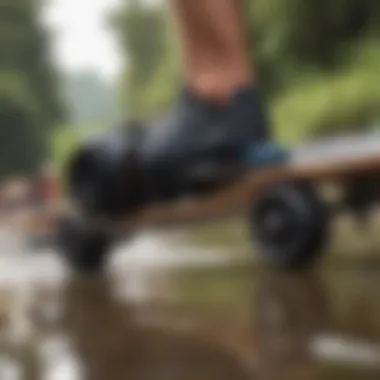
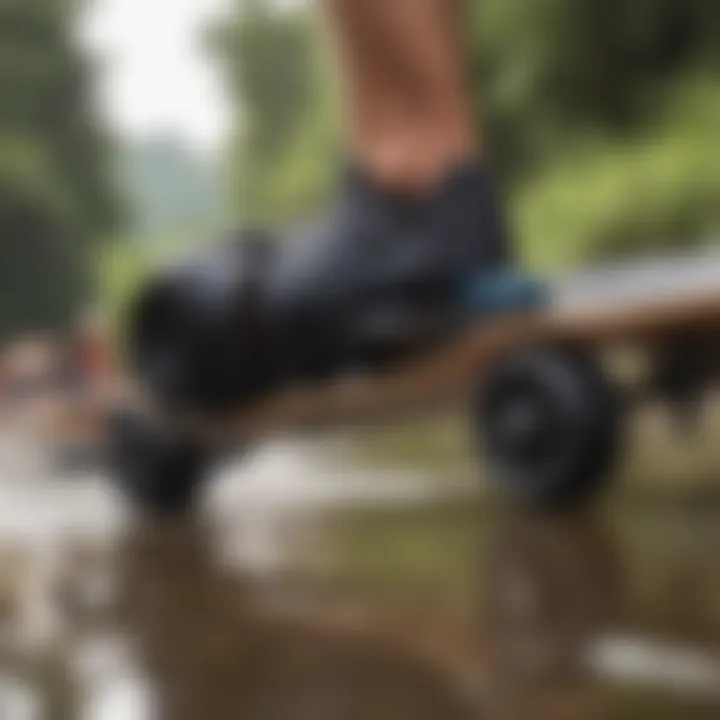
The landscape of longboard racing is as diverse as the riders who glide on them. Each type presents unique challenges and thrills, ensuring that whether you're a novice or a seasoned pro, there’s something to suit every taste. Understanding the various styles is crucial for anyone looking to delve deeper into this sport; it’s not just about speed—each type fosters distinct skills and encourages different strategies.
Downhill Racing
Downhill racing is where the heart of adrenaline truly beats. Riders sprint down mountains or steep roads, facing tight turns and high speeds. Often described as a rush you can't quite get enough of, this style demands skill and an acute awareness of the terrain. Riders often reach speeds that make your stomach churn; it’s not uncommon to see competitors zooming down slopes at over 40 miles per hour.
When engaging in downhill racing, selecting the right longboard is vital. The board's design influences maneuverability and speed, making it essential to choose one that fits your style, be it a stiff or flexy board. Each rider must also be mindful of their setup: including truck angles, wheel hardness, and length of the board plays a decisive role.
"In downhill racing, every second counts, and the difference between the finish line and a nasty spill could hinge on just a single turn."
Slalom Racing
Slalom racing embodies agility and precision. It's not just about speed; it requires intricate weaving through a series of cones or markers. The goal is to navigate the course as swiftly as possible, showcasing the rider’s ability to control their board under varied speed conditions. Riders of all skill levels engage in slalom racing, making it highly accessible.
Setting up for slalom racing often involves fine-tuning your board to enhance responsiveness. Variables like wheel size and grip can significantly impact performance in this high-stakes contest. Riders can choose between numerous configurations, depending on the track and their personal preferences.
Freeride Events
Freeride events combine the best of both worlds. They typically include downhill portions, but they also allow riders the freedom to perform tricks, slides, and other stylish maneuvers. Picture this: a mix of racing down steep hills, the thrill of carving smoothly, and showcasing creativity all at once. It’s a celebration of individuality in the world of longboarding.
Freeriding encourages riders to express their personality and test their skills in an environment that isn’t strictly competitive. Riders can experiment with different techniques from racing or slalom, learning how to manage their speed and body positioning. The beauty of freeride lies in its flexibility—every runner can define their experience.
Understanding these various types of longboard racing will not only enhance your overall experience but also help you find which one resonates with your style and skill set. The blend of speed, technique, and creativity encountered across these formats creates a rich tapestry that draws enthusiasts from around the globe.
Essential Gear for Longboard Racing
When it comes to longboard racing, the right gear is not just a luxury—it is essential. Racing integrates speed and agility, where even the slightest miscalculation can send you tumbling down the hill. Using inadequate equipment can compromise not only your performance but also your safety. Hence, having the proper gear ensures not just a successful competition but also enhances the overall riding experience. Below, we delve into critical gear choices that can elevate your longboarding endeavors.
Choosing the Right Longboard
Picking the right longboard is akin to a chef selecting the perfect knife; you need tools that complement your skill set and meet your racing style. The longboard serves as your primary vessel, so it's imperative to choose wisely. Options adorn the market, but you should focus on variables such as shape, weight, length, and deck material.
A few tips on what to consider:
- Length: Longer boards often provide stability, ideal for downhill racing, while shorter boards enhance maneuverability, perfect for slalom.
- Deck Material: Options like bamboo, maple, and fiberglass each offer unique flex characteristics, affecting ride quality.
- Wheels: The durometer of the wheel dictates its hardness. Softer wheels grip better on curvy paths, whereas harder wheels glide more swiftly.
Remember, a well-chosen longboard can be the deciding factor in tweaking your racing strategy and can, in many cases, mean the difference between first and second place.
Protective Equipment
Longboard racing might feel exhilarating, but just a slip can result in injuries that can haunt you for weeks. That’s where protective equipment comes in, serving as your armor in the heat of the race.
Key components include:
- Helmets: A sturdy helmet is an absolute must. Look for a model that fits snugly and meets safety certifications. Trust me, there are no prizes for style points in this scenario.
- Pads: Elbow and knee pads provide necessary protection against scrapes and bruises. When you're zipping down a hill, your joints need all the help they can get.
- Gloves: Sliding gloves equipped with pucks can save your palms when hitting the ground. They also double as a great tool for initiating slides.
Prioritizing protective equipment can drastically reduce both the frequency and severity of injuries, allowing you to focus solely on improving your skills and strategies during competitions.
Maintaining Your Gear
It’s no secret: without regular maintenance, any gear can quickly deteriorate. Longboards are no different, especially when they're being pushed to their limits. Developing a consistent maintenance routine ensures longevity of your equipment and optimal performance.
Here are some practical pointers:
- Check the Bearings: Regularly examine and lubricate your bearings. Dirt or corrosion can significantly slow you down.
- Tighten Hardware: The vibrations and impact of racing can loosen bolts and screws. A quick inspection before each ride can go a long way.
- Inspect the Wheels: Look for any flat spots or uneven wear on your wheels. Rotating them or replacing them as needed can maintain speed and control.
"Taking care of your gear not only extends its life, it can actually enhance your performance. Treat your board like a partner, and it will return the favor."
In summary, understanding the significance of essential gear for longboard racing can make all the difference in your performance and safety. Consider your choices carefully and maintain your equipment regularly to ride with confidence. Happy racing!
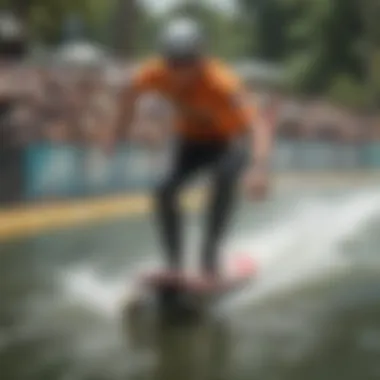
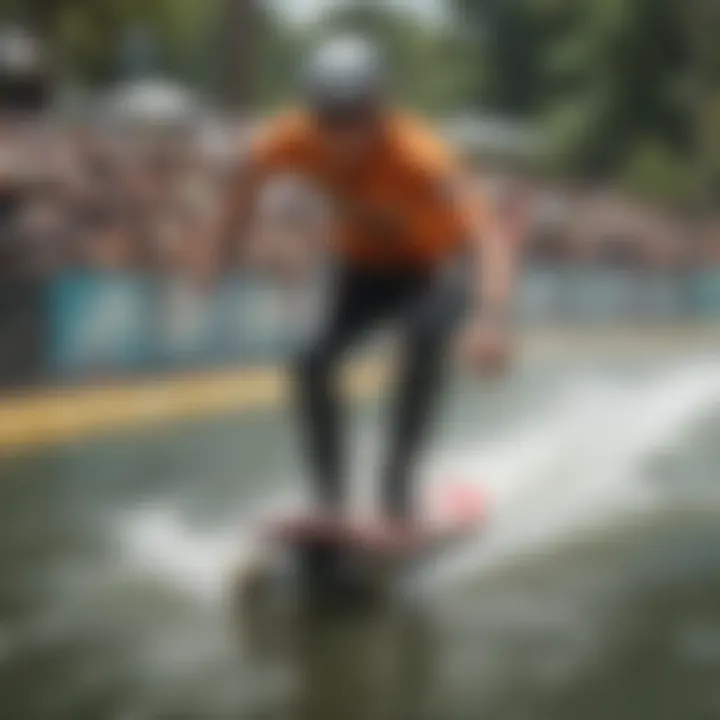
Techniques and Strategies
In longboard racing, mastering techniques and strategies is crucial for both safety and performance. The right technique not only enhances a rider's speed but also improves handling in various conditions. From novice riders to experienced racers, understanding these elements can be a game changer. Techniques vary in complexity, and leveraging the appropriate strategy can determine outcomes in competitive scenarios. Developing solid core skills can lead to smoother runs and quicker decision-making when facing challenges during a race.
Basic Riding Techniques
For any beginner, it’s essential to start with basic riding techniques. These foundational skills set the stage for more advanced maneuvers later on. Here are some core aspects to focus on:
- Stance: Your foot positioning is critical. A stable stance, with your front foot just behind the front truck bolts, aids in better control and balance.
- Pushing: Acquiring the right pushing technique can help maintain speed efficiently. It's about finding the balance between stride length and cadence.
- Turning: Mastering gradual turns, as well as sharper cuts, requires practice. Engaging your knees and leaning into the turn can offer better grip and flow.
"Mastering the basics creates a solid foundation for all who aspire to advance in longboarding."
- Stopping: Knowing how to stop is just as important as going fast. Techniques such as foot braking or sliding are critical for safe stops.
Once you're comfortable with these basic techniques, riders can progress and explore more advanced techniques.
Advanced Maneuvers
After mastering the basics, riders can explore advanced maneuvers that can enhance their performance and control on the board. Here are a few:
- Carving: This involves making linked turns to maintain speed. Effective carving can minimize friction and keep the board flowing smoothly.
- Sliding: A technique used to control speed by letting the board slide sideways. This can be particularly helpful in downhill races where speed control is crucial.
- Tuck Position: Adopting a tuck can significantly reduce wind resistance. This position lowers the center of gravity and lends itself to higher speeds.
These advanced techniques can provide an edge in racing conditions, but they require practice and finesse to ensure safety and effectiveness.
Race Day Strategies
On race day, it's not just about physical skill; race day strategies play an integral role in success. Here are some key strategies to consider:
- Course Familiarization: Knowing the layout of the course can help you anticipate turns or tricky spots, giving you an advantage.
- Start Position: Where you place yourself at the start line can impact your overall race flow. It’s often advantageous to start where you can make the first turn with ease.
- Pace Yourself: It’s easy to get overexcited. Finding a sustainable pace can be more beneficial than starting too fast and burning out.
- Watch Competitors: Pay attention to their techniques and strategies. Keeping an eye on your rivals’ positions might give insight into tactics they’re employing.
Safety Considerations
In the adrenaline-charged world of longboard racing, the excitement of speed can sometimes cloak the essential need for safety. Riders thrill at the notion of racing down steep hills or weaving through complex slalom courses, but understanding the risks involved is paramount. Recognizing safety considerations can dramatically enhance not only the enjoyment of the sport but also the longevity of one's participation in it. Failing to appreciate these elements can lead to unfortunate incidents that detract from the sport's vibrant community.
Understanding Risks
Every time a rider steps onto their longboard, there’s an element of risk involved. The exhilaration of carving through turns at high speeds comes with inherent dangers, including falls, collisions, and environmental hazards. More specifically, the risks include:
- Surface Hazards: Uneven pavement, loose gravel, or debris can pose significant dangers, causing loss of control.
- Speed-related Dangers: High velocity can lead to severe injuries; even a simple fall can result in road rash or fractures.
- Environmental Factors: Weather conditions such as rain can make surfaces slippery, while hills and curves may hide unavoidable obstacles.
Understanding these risks is essential in creating a safe racing experience. Acknowledging what could happen not only prepares the rider mentally but also instills a sense of responsibility towards oneself and the community. When riders advocate for safety, they pave the way for a culture where everyone looks out for one another—a fundamental value in longboard racing.
Best Practices for Safety
Considering the risks presents the opportunity to develop best practices, ensuring that fun does not come at the cost of safety. A few foundational principles can be quite effective:
- Wear Protective Gear: Helmets, knee pads, elbow pads, and wrist guards should become part of a racer’s uniform. These pieces can drastically reduce injury risks, providing a safety net even during spills.
- Stay Aware of the Environment: Before hitting a course, scan for potential dangers. Pay attention to road conditions, traffic, and weather.
- Choose the Right Location: Not all spots are suitable for racing. Look for designated tracks that are designed for longboarding, reducing the chance of unexpected interruptions.
- Practice Regularly: The more acquainted a rider becomes with their board, the more intuitive their movements will be. Regular practice can help develop necessary reflexes that aid in navigating through potential hazards effectively.
- Communicate with Others: Whether racing against friends or engaging in community events, clear communication can prevent misunderstandings that lead to accidents. Use hand signals to indicate turns or stops when in a group.
- Invest in a high-quality helmet that meets safety standards. Brands like TSG and Bell specialize in protective equipment tailored for boardsports.
- Consider traveling in pairs or groups; having a buddy watching out can mean catching hazards early.
- Local communities often organize events in safe, controlled settings where riders can hone their skills.
"Safety is not just a rule; it’s a way to keep the ride enjoyable for all involved."
By implementing these best practices, racers can significantly mitigate risks while enjoying what the sport has to offer. Ultimately, safety considerations are just as essential as the thrill of racing down a slope; both elements should coexist harmoniously in the longboard racing experience.
The Community and Culture of Longboard Racing
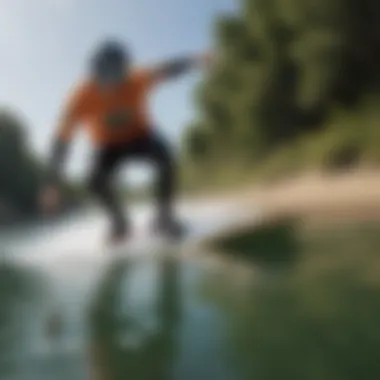

Longboard racing is more than just speed and skill; it embodies a vibrant community that brings together enthusiasts from different backgrounds. This culture signifies connection, shared experiences, and camaraderie among riders. This section explores the significant aspects of the longboard racing community, focusing on events, gatherings, and online platforms that foster these relationships.
Racing Events and Gatherings
Community gatherings in longboard racing are where thrill meets social interactions. Events such as the Maryhill Festival of Speed in Washington State or the Downhill Disco in California represent the pinnacle of these dynamics. These events attract riders from near and far, creating an atmosphere buzzing with excitement.
Taking part in these events facilitates bonding moments that extend beyond the race track. Competitors often share tips, techniques, and stories, enabling newer riders to find their footing in the sport. It is here that many learn the ropes—everything from the importance of choosing the right board to mastering tricky turns.
Moreover, these gatherings serve as a showcase for local talent and innovative gear. Vendors often use such platforms to unveil new longboarding equipment, adding a commercial aspect to the thrills. It's not just about the races; it’s also about being part of a larger narrative that celebrates passion and perseverance. Here are some of the benefits of these events:
- Building Relationships: Interactions at the races lead to lasting friendships that transcend competitions.
- Skill Development: Beginners can learn from seasoned professionals, which is an advantage for anyone looking to improve.
- Showcasing Talent: For many, these events are a launching pad to bigger competitions and sponsorships.
Online Communities and Resources
In today’s digital age, online communities significantly contribute to the longevity of longboard racing culture. Platforms like Reddit and Facebook host various groups where riders can exchange information, post videos, and share their experiences. These groups provide a space for all levels of riders, from curious newcomers to veteran racers, to come together.
Forums dedicated to longboarding, such as the subreddit dedicated to longboarding, offer a wealth of knowledge on gear reviews, racing tips, and local meet-ups. Members often engage in discussions that cover a vast range of topics—from DIY maintenance to the latest trends in board shapes and materials.
These online spaces hold vital educational resources. Riders can access:
- Tutorials and Guides: Videos and articles on improving riding techniques and safety practices can be found easily.
- Event Announcements: Staying updated on upcoming races and gatherings is simpler through these platforms.
- Support Networks: For anyone dealing with injuries or seeking advice, these communities often provide positive reinforcement.
"The beauty of longboarding isn't just in the ride; it's in the tribe. From races down steep hills to friendly banter in online discussions, community fuels the passion.
Engaging in these online groups can often complement the experiences gathered from real-life events. This blend of digital and physical communities solidifies longboard racing as not just a sport but a culture. For many enthusiasts, it creates a sense of belonging that enriches their riding experience.
The Future of Longboard Racing
As longboard racing continues to carve its path within the sport community, understanding its future holds significant value not just for current racers but also for enthusiasts and potential entrants. This glimpse into what lies ahead is crucial in recognising the evolution in racing dynamics, trends, and technological enhancements. A well-informed perspective can increase participation rates and foster a healthier, more vibrant community.
Emerging Trends
One key ingredient shaping the future of longboard racing lies in the trends that are rising to the surface. We cannot ignore the growing social media presence of longboarding, which has transformed how racers engage with one another. Platforms like Instagram and TikTok have allowed riders to showcase their skills, share tips, and participate in challenges that transcend geographical barriers.
Moreover, there is a palpable shift towards inclusivity in racing. Races that embrace all skill levels, from weekend warriors to seasoned pros, are becoming more common. Events like the Downhill Southeast series in the United States exemplify how organizers are creating spaces for diverse participants to shine. Such developments not only enrich the competitive scene but also create tighter-knit communities where support and camaraderie flourish.
Another noteworthy trend comes from the increasing popularity of electric longboards. These boards are making the sport more accessible to newcomers and fostering a unique racing style that is likely to become a staple in future competitions.
- Popularity of electric longboards
- Rise of inclusive competitions
- Increased visibility through social media platforms
Technological Advancements
Technological leaps are also casting a bright light on the road ahead for longboard racing. Innovations in board design and materials are revolutionizing performance. Manufacturers are experimenting with lightweight composites and advanced grip systems, which not only enhance speed but also improve control.
In addition, the introduction of data-tracking technology has begun to play a role in training and racing strategies. Fitness trackers that monitor crucial metrics such as speed, heart rate, and movement can offer racers insights into their performance, allowing them to refine their techniques. This data can even assist in understanding optimal racing conditions, thus bringing a scientific angle to a sport often perceived as purely skill-based.
"In the fast-paced world of longboard racing, staying ahead of the curve with technology can mean the difference between winning and just participating."
Furthermore, virtual reality (VR) technology is likely to be the next big thing in training, immersing riders in race simulations that help them practice maneuvering in a safe environment. This blend of real and digital realms will create a more prepared racing cohort, ready to tackle any course thrown their way.
In summary, the future of longboard racing is painted with excitiing possibilities characterized by emerging trends and advancements in technology. As the sport evolves, it continues to attract new blood while nurturing the seasoned veterans, ensuring a lively and diverse community that remains invested in both performance and safety.
End
Wrapping up our journey through the intricate world of longboard racing, it becomes clear that this sport is more than just a thrill-seeking endeavor. It embodies a vibrant community tied by a shared passion. With roots that delve into a rich history and blossoming into various competitive formats, longboarding offers a plethora of experiences for both participants and spectators alike.
A key aspect to consider is the growth of longboard racing as a legitimate sport. The birth of new racing events, along with the advent of innovative gear, has created a platform that demands both dedication and skill. This evolution in the sport not only promotes healthy competition but also fosters camaraderie among racers.
Benefits of engaging in longboard racing:
- Skill Development: Riders can hone their balance, coordination, and control while mastering different techniques.
- Community Connection: The sense of belonging to a group of passionate individuals creates lasting friendships and networks.
- Adrenaline Rush: There’s simply nothing like the swift glide down steep hills, a sensation that captivates many.
In light of our exploration, several considerations stand out. Enthusiasts should always prioritize safety, ensuring they are well-equipped with appropriate gear and knowledge about track conditions. Additionally, as technology continues to advance, it’s essential to stay informed about the latest trends that can enhance performance.
"With great speed comes great responsibility."
Embracing the sport of longboard racing is an exhilarating ride, but riders must remain vigilant. Whether you’re just starting or have years of experience under your belt, the community supports continuous learning, evolving skills and sharing knowledge.















